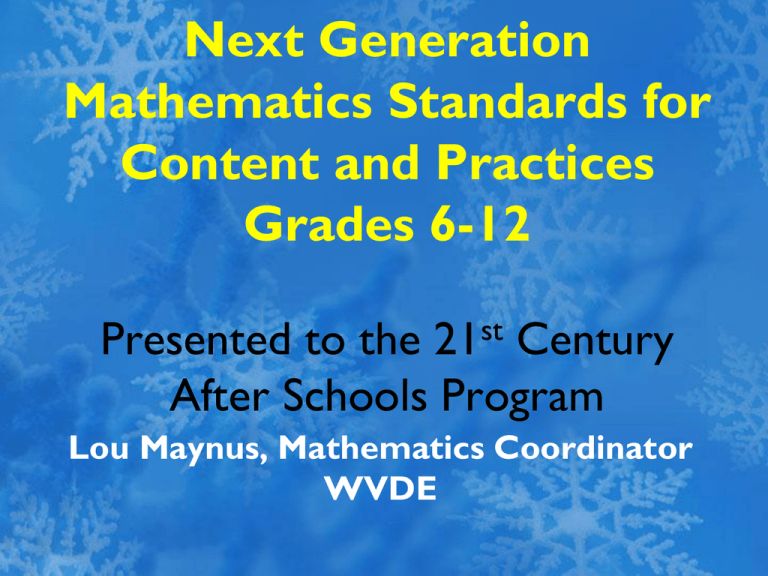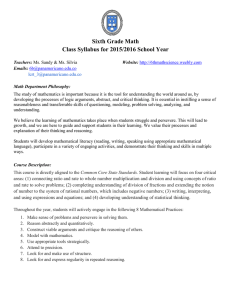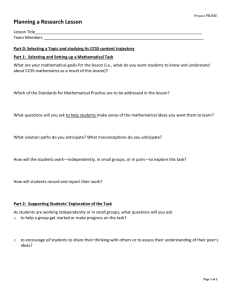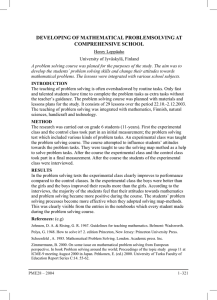Next Generation Mathematics Standards for Content and Practices Grades 6-12
advertisement

Next Generation Mathematics Standards for Content and Practices Grades 6-12 st 21 Presented to the Century After Schools Program Lou Maynus, Mathematics Coordinator WVDE CCSS Math Content PreK K 1 2 3 4 5 6 7 8 HS Mathematical Practices Counting & Cardinality Number & Operations in Base Ten Number & Operations Fractions Operations & Algebraic Thinking Ratios & Proportional Relationships The Number System Number & Quantity Expressions & Equations Algebra Functions Geometry Measurement & Data Statistics & Probability 2 Practice Standards 1. Make sense of problems & persevere in solving them. 2. Reason abstractly & quantitatively. 3. Construct viable arguments & critique the reasoning of others. 4. Model with mathematics. 5. Use appropriate tools strategically. 6. Attend to precision. 7. Look for & make use of structure. 8. Look for & express regularity in repeated reasoning. 3 Content & Practices • Understand is used in the CCSS to mean that students can explain the concept with mathematical reasoning, including – Justifying why a particular mathematical statement is true, – Explaining where a mathematical rule comes from – Giving concrete illustrations, and – Providing mathematical representations & example applications. 4 Content & Practices Standards that begin with “understand” are good opportunities to connect the Practices to the Content! 5 Content & Practices • “A lack of understanding (of the content) effectively prevents a student from engaging in the Mathematical Practices.” • “Conceptual understanding is not an option – it is an expectation!” Skip Fennell, former NCTM president 6 Standards for Mathematical Practice • Carry across all grade levels • Describe habits of mind of a mathematically expert student • Describe varieties of expertise that should be developed in students • Rely upon longstanding important processes and proficiencies • Articulate the behaviors of mathematically competent students 7 Practice Standards • A big part of the intent of the Math Practices requires that the Content be taught through the Practices. That way, the connections are real – integrated rather than interspersed. • The Standards for Mathematical Practice are what students who understand mathematics “do” with the content. 8 17 Great Tasks Matter! 18 Answer Getting vs Learning Math • US: – How can I teach my kids to get the answer to this problem? • Japan: – How can I use this problem to teach mathematics they don’t already know? 19 Tasks Matter • “There is no decision that teachers make that has a greater impact on students’ opportunities to learn and on their perceptions about what mathematics is than the selection or creation of the tasks.” Lappan & Briars, 1995 • “If we want students to develop the capacity to think, reason, and problem solve then we need to start with high-level, cognitively complex tasks.” Stein & Lane, 1996 20 Tasks Matter • “Not all tasks are created equal, and different tasks will provoke different levels and kinds of student thinking.” Stein, Smith, Henningsen, & Silber, 2000 • “The level and kind of thinking in which students engage determines what they will learn.” Heibert, Carpenter, Fennema, Fuson, Wearne, Murray, Oliver, & Human, 1997 • “The problems we encounter in the real world rarely tell us exactly what question we need to answer and they almost never tell us where to begin.” Thinkmath.edc.org 21 Tasks Matter • “Mathematical understanding and procedural skill are equally important, and both are assessable using mathematical tasks of sufficient richness.” Common Core Standards, 2010 • CCSS ask you to connect the Content Standards and the Practice Standards. This happens in the context of good problems. 22 Dan Meyer: Math Class Needs a Makeover TED Talk http://www.ted.com/talks/dan_meyer _math_curriculum_makeover.html 23 What is a Great Task? A Great Task: 1. Is open-ended 2. Does not have a solution path that is immediately obvious (or implied) 3. Requires examination & perseverance – challenges students 4. Requires students to think and not just rely on memorized procedures 24 What is a Great Task? A Great Task: 5. Begs for discussion – offering rich discourse on the math involved 6. Requires students to connect mathematical skill, understanding and reason 7. Requires students to interpret and communicate results 25 Why use a Great Task? • The primary use of great tasks is as a tool for teachers to evaluate the depth of student understanding, to catch misconceptions, and as a foundation for classroom discourse designed to extend students’ thinking. • Great tasks allow students to demonstrate their thinking and give their teachers insight into student understandings and misconceptions. • Great tasks provide opportunities to evaluate reasoning and examine sense making. NCSM Great Tasks for Mathematics , 2011 26 Tips to Help Students Persevere • Pose problem, make sure students understand the language, no hints at the solution • Focus students on the problem situation, not the question/answer game. Hide question and ask them to formulate questions • Require students to start by explaining to themselves the meaning of the problem and looking for entry points • Occasionally pose problems that ask only for the analysis and not for a numeric answer to its solution 27 North Shore Swim Club Annual Breakfast In Summary • Promote the standards for mathematical practice. • Choice rich tasks that children will want to solve and integrate the content with the practices.








